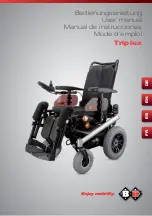
25
EN
GLISH
Zippie & Teens Seat Rev. A
1
A
45°
Fig. 4.54
Fig. 4.55
Fig. 4.56
Fig. 4.57
4.21
Lap strap / seating positioning belt
DANGER! / WARNING!
• This product is only to be used to position a single person in a
wheelchair.
• Lap straps are not suitable for transit purposes, approved occupant
restraint systems must be used.
• Failure to heed these warnings may result in severe injury or death.
• Ensure that the carer or attendant is trained in the correct
operation of the belts.
• Untrained carers or attendants may lead to delays, if an emergency
situation occurs.
Mounting a lapstrap / seating positioning belt
1. Attach (A) to the seating frame using a screw on the left and on
the right. (Fig 4.55)
Positioning an person with a lapstrap
• Adjust the lap strap to suit, leaving no more than a hand’s width
gap for comfort and safety (Fig 4.56).
• The hand clearance should be with the lap strap under normal
tension and not allow large gaps or loops.
• Generally, the lap strap should be fixed so that the straps sit at an
angle of approximately 45° (Fig. 4.57), and when correctly adjusted
should not allow user to slip down in the seat.
• Place the strap loosely across the seat with the opening end of the
buckle facing to the right for a left-handed person and to the left for
a right-handed person. Pass the other ends of the strap through the
gap between the backrest posts and the backrest.
DANGER! / WARNING!
• Always make sure that the lap strap is correctly secured and
adjusted prior to use.
• If a strap is too loose it could cause the user to slip down and cause
serious injury.
• Check lap strap and securing components at regular intervals for
any signs of fray or damage. Replace if necessary.
• When servicing, check for correct operation of the release buckle
and for any signs of wear on the material or plastic brackets.
• Regular Checks/Activities:
• As with all positioning components, there is a need for corrective
adjustments as the person changes their seating position over time.
• Check the belts regularly for correct fitting, to ensure the safety and
comfort of the user.
















































